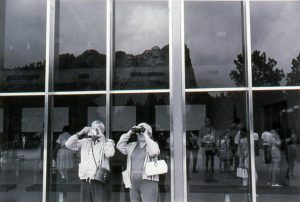
![]() From early in his distinguished career, Lee Friedlander has been fascinated by reflections, fragments of vision, and ironies in the visual landscape. With complex compositions and spatial ambiguities, he makes us question where we stand and what we see.
From early in his distinguished career, Lee Friedlander has been fascinated by reflections, fragments of vision, and ironies in the visual landscape. With complex compositions and spatial ambiguities, he makes us question where we stand and what we see.
In his photograph Mt. Rushmore, South Dakota, Friedlander focuses on the built environment in a variety of ways. Two figures stand in front of a bank of windows in which the monumental sculpture of Mt. Rushmore is reflected. We see figures inside the building, as well as others who are reflected on it. An elderly couple studies the monument, as we study them.
The landscape is reduced to a mere shadow of itself, as trees, clouds, and the mountain are held within the metal grid of the windows. Nature gives way to culture in the photograph, as the mountain has given way to the carved figures on its face.
Although many of us consider Mt. Rushmore as a monument to the American presidency, this altered landscape is considered a desecration by some native peoples. The Black Hills, home to Mount Rushmore, are considered sacred by the Lakota Sioux, who have sought return of the land. The mountain itself, known as Six Grandfathers, is an especially contested site.